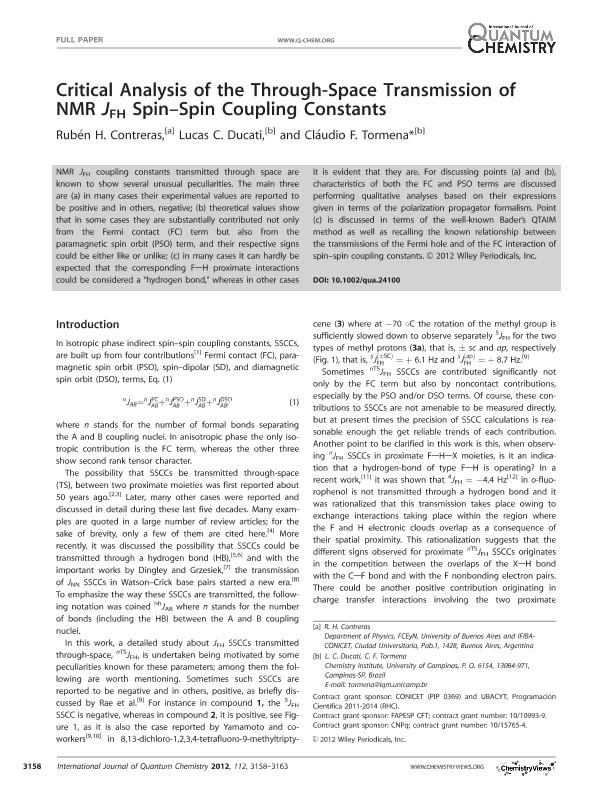Mostrar el registro sencillo del ítem
dc.contributor.author
Contreras, Ruben Horacio

dc.contributor.author
Ducati, Lucas C.
dc.contributor.author
Tormena, Cláudio F.
dc.date.available
2018-08-15T17:12:31Z
dc.date.issued
2012-05
dc.identifier.citation
Contreras, Ruben Horacio; Ducati, Lucas C.; Tormena, Cláudio F.; Critical analysis of the through-space transmission of NMR J FH spin-spin coupling constants; John Wiley & Sons Inc; International Journal of Quantum Chemistry; 112; 19; 5-2012; 3158-3163
dc.identifier.issn
0020-7608
dc.identifier.uri
http://hdl.handle.net/11336/55634
dc.description.abstract
NMR J FH coupling constants transmitted through space are known to show several unusual peculiarities. The main three are (a) in many cases their experimental values are reported to be positive and in others, negative; (b) theoretical values show that in some cases they are substantially contributed not only from the Fermi contact (FC) term but also from the paramagnetic spin orbit (PSO) term, and their respective signs could be either like or unlike; (c) in many cases it can hardly be expected that the corresponding F-H proximate interactions could be considered a "hydrogen bond," whereas in other cases it is evident that they are. For discussing points (a) and (b), characteristics of both the FC and PSO terms are discussed performing qualitative analyses based on their expressions given in terms of the polarization propagator formalism. Point (c) is discussed in terms of the well-known Bader's QTAIM method as well as recalling the known relationship between the transmissions of the Fermi hole and of the FC interaction of spin-spin coupling constants. © 2012 Wiley Periodicals, Inc. From QTAIM parameters, the presence of F-H hydrogen bonds for 1 and 2 were assessed. Considering that the sign of TSJ FH SSCC is negative for 1, whereas it is positive for 2, it is concluded that the TSJ FH SSCC sign is not indicative of the presence or absence of an F-H hydrogen bond. Instead, such different signs are indicative that their Fermi contact contributions are transmitted by exchange interactions. The actual sign is determined by the competition between the LP 1(F)/C-H and C-F/C-H overlaps, which yield different sign contributions. Copyright © 2012 Wiley Periodicals, Inc.
dc.format
application/pdf
dc.language.iso
eng
dc.publisher
John Wiley & Sons Inc

dc.rights
info:eu-repo/semantics/openAccess
dc.rights.uri
https://creativecommons.org/licenses/by-nc-sa/2.5/ar/
dc.subject
1hj Fh
dc.subject
Fermi Hole
dc.subject
Hydrogen Bond
dc.subject
Proximity Effect
dc.subject
Through-Space Transmission
dc.subject.classification
Otras Ciencias Químicas

dc.subject.classification
Ciencias Químicas

dc.subject.classification
CIENCIAS NATURALES Y EXACTAS

dc.title
Critical analysis of the through-space transmission of NMR J FH spin-spin coupling constants
dc.type
info:eu-repo/semantics/article
dc.type
info:ar-repo/semantics/artículo
dc.type
info:eu-repo/semantics/publishedVersion
dc.date.updated
2018-08-10T17:44:33Z
dc.journal.volume
112
dc.journal.number
19
dc.journal.pagination
3158-3163
dc.journal.pais
Estados Unidos

dc.journal.ciudad
New York
dc.description.fil
Fil: Contreras, Ruben Horacio. Universidad de Buenos Aires; Argentina. Consejo Nacional de Investigaciones Científicas y Técnicas. Oficina de Coordinación Administrativa Ciudad Universitaria. Instituto de Física de Buenos Aires. Universidad de Buenos Aires. Facultad de Ciencias Exactas y Naturales. Instituto de Física de Buenos Aires; Argentina
dc.description.fil
Fil: Ducati, Lucas C.. Universidade Estadual de Campinas; Brasil
dc.description.fil
Fil: Tormena, Cláudio F.. Universidade Estadual de Campinas; Brasil
dc.journal.title
International Journal of Quantum Chemistry

dc.relation.alternativeid
info:eu-repo/semantics/altIdentifier/doi/http://dx.doi.org/10.1002/qua.24100
Archivos asociados
